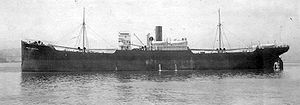SS Pan Kraft
 West Avenal, sister ship to Pan Kraft | |
| Career | |
|---|---|
| Name: | Pan Kraft |
| Operator: | Waterman Steamship Company |
| Builder: | Western Pipe & Steel |
| Yard number: | WPS Hull No. 11 |
| Launched: | July 2, 1919 |
| Christened: | West Kader |
| Acquired: | December 31, 1919 |
| Homeport: | Wilmington, Delaware |
| Fate: | Sunk by bombing, July 7, 1942 |
| General characteristics | |
| Tonnage: | 5570 gross tons, 3468 net, 8,800 deadweight |
| Length: | 410 ft 6 in (125.12 m) |
| Beam: | 54 ft (16 m) |
| Draft: | 24 ft 1½ in (7.353 m) |
| Propulsion: | Joshua Hendy 3-cylinder triple expansion, 2800 IHP |
| Speed: | 11 knots |
| Crew: | 44 |
Pan Kraft was a cargo ship built in 1919 by the Western Pipe and Steel Company of California. She was one of eighteen ships built by the company for the U.S. Shipping Board. After merchant service between the wars, she was to become one of the victims of Great Britain's disastrous Convoy PQ-17 to Russia during World War II.
Operational history
Pan Kraft was launched as West Kader on July 2, 1919 and delivered to the Shipping Board on December 31, 1919. She made her maiden voyage between Portland, Oregon and the Far East on January 8, 1920, and in August of the same year made a trip to Cork, Ireland. From April 1920 to April 1928, West Kader continued to operate from Portland, Oregon to China, Japan, Russia, the Philippines and Hong Kong.
On June 4, 1928, West Kader was sold by the U.S. Shipping Board to the States Steamship Company of Portland, Oregon, who renamed her New York. Her homeport remained Portland until 1937 when she was sold to the Everett Steamship Company of Mobile, Alabama, who renamed her Pan Kraft and homeported her in Mobile.
Pan Kraft was acquired by Pan Atlantic Steamship Corporation in 1939 though her homeport remained Mobile, but after Waterman Steamship became manager of the vessel, she was re-homeported in Wilmington, Delaware.
Convoy PQ-17
Following the outbreak of World War II and America's entry into the war, Pan Kraft was assigned a delivery of military equipment to the Soviet Union under the US-Soviet lend-lease agreement. With a deck full of planes and cargo holds full of crated aircraft, Pan Kraft made the first leg of her journey from New York to Hvalfjordur, Iceland, where she joined with other merchant vessels and a Royal Navy escort to form Convoy PQ-17. The convoy departed for the Russian port of Arkangelsk on June 24, 1942.
On July 4, the commander of PQ-17's naval escort was informed that the German battleship Tirpitz was on course to intercept. He made the fateful decision to scatter the convoy, with disastrous results. German U-boats and aircraft were able to pick off the isolated ships with ease, sinking 25 of the convoy's 36 merchant vessels and putting PQ-17 into the record books as the greatest Russia-bound convoy loss of the war.
Pan Kraft was not to be one of the fortunate few to escape. On July 5 she was attacked in the Barents Sea by Junkers Ju-88 bombers, and though she did not suffer a direct hit, her oil and steam lines were ruptured and she had to be abandoned. The convoy escort HMS Lotus then attempted without success to sink the disabled vessel, but at 6 am on July 7 Pan Kraft finally sank after suffering an internal explosion.
Two more of the convoy's ships were sunk on the return journey.
References
- Mawdsley, Dean L. (2002): Steel Ships and Iron Pipe: Western Pipe and Steel Company of California, the Company, the Yard, the Ships, Glencannon Press (for Associates of the National Maritime Museum Library), ISBN 1-889901-28-8, page 105.
| ||||||||
